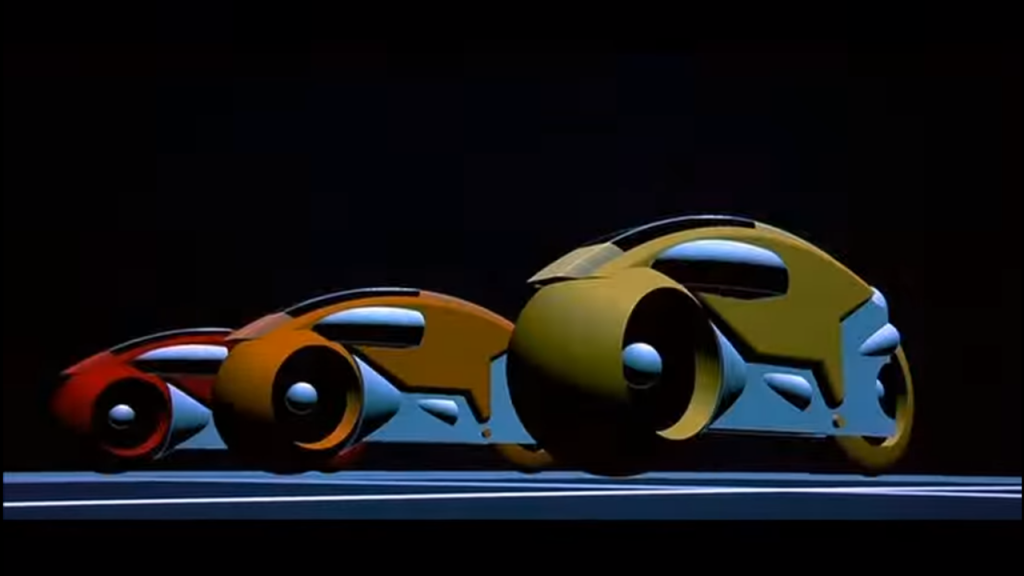
How the pioneering motion picture influenced CGI in television and film
By Clive Ramroop, Contributor
“Greetings, programs!”
On July 9, 1982, a motion picture crept into theatres, introducing audiences to a cyberspace adventure inside a computer. While TRON was only a minor hit overshadowed by E.T. the Extra-Terrestrial dominating the box office, its innovative 3D computer graphics became a launchpad for TV and film productions to spawn more creative milestones in those media.
In The Making of TRON, a documentary on the movie’s DVD, storyboard artist and animator Bill Kroyer recalled the difficulty of using early computers for a movie: “There really was no software to make anything move … only software to describe where things sat. Let’s say you got an object like a light cycle. For every frame that it moves, it will need at least six numbers to describe its position; its X-, Y-, and Z-translations to show where it is in space. For 100 frames, you need 600 numbers of data—100 frames is 4 seconds. Then we gave these guys at the computer company these exposure sheets with six rows of numbers for every single frame, and they typed them in. There was no way to just download it. And the very first time we would see it move … we would stand there in front of this gigantic 70-mm screen, and they would run this film on a projector. That was our ‘pencil test,’” Kroyer said in the documentary.
Director Steven Lisberger, in the documentary, described the movie as “highly experimental” and “cutting-edge,” but also added, “The Motion Picture Academy refused to nominate TRON for special effects, because they said we ‘cheated’ when we used computers, which, in light of what happened, is just mind-boggling.”
Indeed, Pixar’s John Lasseter was inspired by TRON to be involved in computer-animated film: “Without TRON, there would be no Toy Story,” he said in the DVD feature.
CGI would creep its way to greater prominence in audio-visual media, before venturing into full CGI productions. A quartet of British animators who made Dire Straits’ “Money for Nothing (1985),” the first CGI music video, moved to Vancouver in the 1990s and created ReBoot: The first 100 per cent CGI cartoon series. In the ReBoot DVD special Alphanumeric: Looking Back at ReBoot, Gavin Blair’s experiences with his pioneering co-creators echoed those of TRON.
“The first episode produced … took the best part of nine months. We had to build all the characters, all the sets, locations, props, everything. And work out how we were going to make the characters talk, develop the software to make the characters talk,” Blair said in the DVD special. “We were basically building the entire universe, and all the characters and working out ways to animate it, render it, get it to tape, edit it. We were answering every question as we went. We were doing something that no one had ever done. A lot of the people we were working with … were from a traditional animation background; what we were doing was way more like live-action production.”
Speaking of which, CGI’s evolution gradually became photorealistic in live-action environments. Among countless milestones since TRON, Terminator 2: Judgment Day (1991) demonstrated realistic human motion with the liquid-metal T-1000, and Jurassic Park (1993) brought dinosaurs out of extinction with the first photorealistic CGI animals. Avatar (2009) would take CGI even further with performance capture technology to generate photorealistic characters that could interact in a photorealistic CGI world. And in The Lord of the Rings: The Two Towers (2002), Andy Serkis attracted worldwide attention (and awards) for his “virtual” performance as the digital character Gollum.
Unfortunately, the Academy repeated its failure to understand computerized advancements in art, refusing Serkis a Best Supporting Actor nomination despite the performer interacting live with other actors on film sets. Leave it to Pixar to notch up one more significant CGI milestone: in 2009, Up would be the first CGI feature to be nominated for a Best Picture Oscar.
If that final milestone of a computer-animated feature film winning Best Picture at the Oscars is ever achieved, perhaps it should consider mentioning TRON in its acceptance speech for building the first step that gained it that prize.
“End of Line…”

